Research Report: BIM Impact on People Management in Construction SMEs
VerifiedAdded on 2023/01/19
|11
|3491
|70
Report
AI Summary
This research report investigates the impact of Building Information Modeling (BIM) on improving people management processes within construction SMEs in London. The report begins with an introduction to BIM, emphasizing its role in 3D project creation, document management, and project lifecycle coordination. It highlights the importance of studying BIM adoption in SMEs, considering government mandates and industry pressures. The research aims to understand BIM's influence on people management, exploring objectives such as understanding BIM, exploring its potential, identifying implementation subsets, evaluating challenges, and providing recommendations for architectural SMEs. The literature review covers the definition and benefits of BIM, its subsets (4D, 5D), and its impact on improving people management processes, such as clash detection and improved data quality. The methodology section outlines research paradigms and approaches (inductive and deductive), setting the stage for the study's findings and conclusions. The report provides a comprehensive overview of BIM and its implications for construction SMEs, making it a valuable resource for students and professionals interested in this topic.

Proposal
1
1
Paraphrase This Document
Need a fresh take? Get an instant paraphrase of this document with our AI Paraphraser
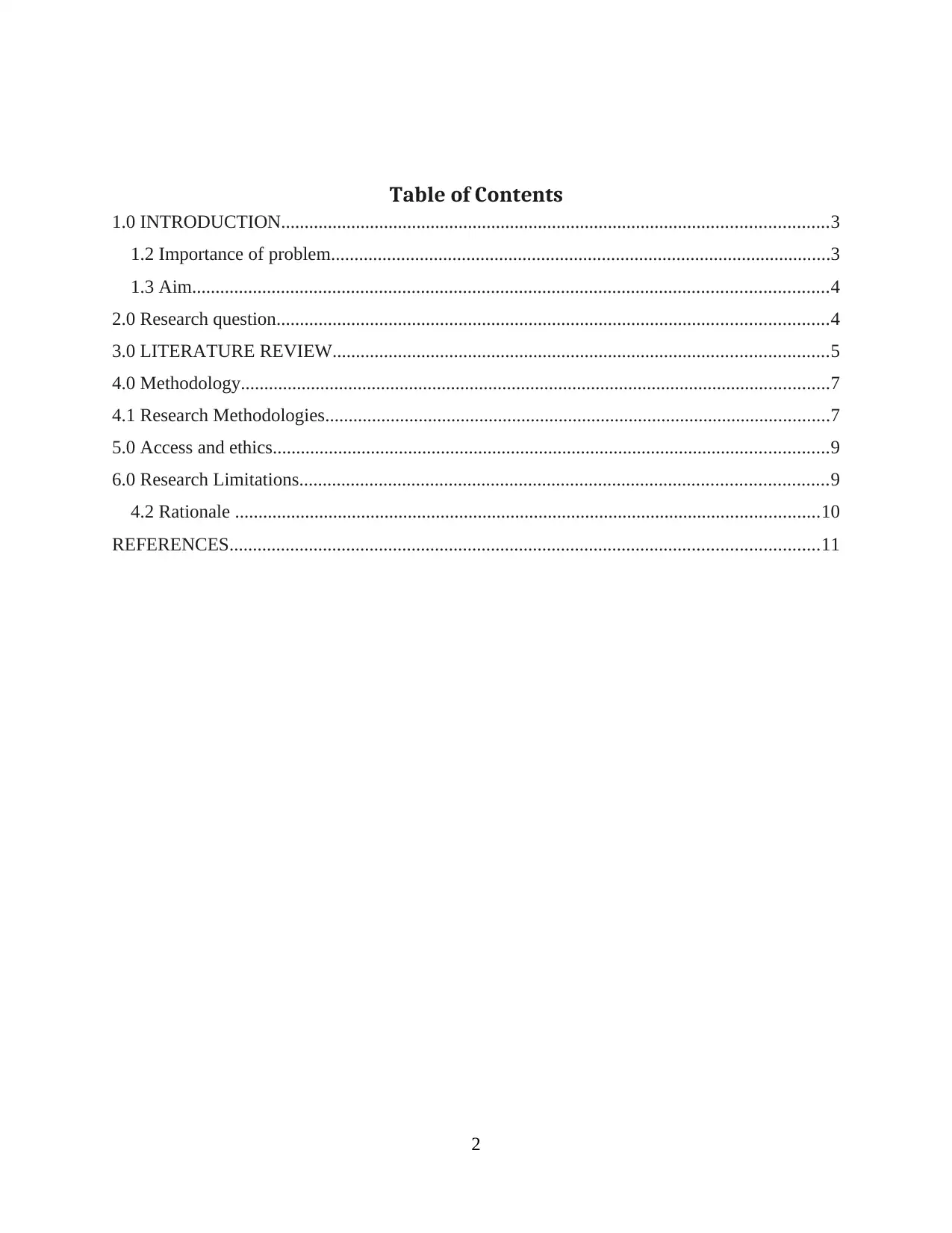
Table of Contents
1.0 INTRODUCTION.....................................................................................................................3
1.2 Importance of problem...........................................................................................................3
1.3 Aim........................................................................................................................................4
2.0 Research question......................................................................................................................4
3.0 LITERATURE REVIEW..........................................................................................................5
4.0 Methodology..............................................................................................................................7
4.1 Research Methodologies............................................................................................................7
5.0 Access and ethics.......................................................................................................................9
6.0 Research Limitations.................................................................................................................9
4.2 Rationale .............................................................................................................................10
REFERENCES..............................................................................................................................11
2
1.0 INTRODUCTION.....................................................................................................................3
1.2 Importance of problem...........................................................................................................3
1.3 Aim........................................................................................................................................4
2.0 Research question......................................................................................................................4
3.0 LITERATURE REVIEW..........................................................................................................5
4.0 Methodology..............................................................................................................................7
4.1 Research Methodologies............................................................................................................7
5.0 Access and ethics.......................................................................................................................9
6.0 Research Limitations.................................................................................................................9
4.2 Rationale .............................................................................................................................10
REFERENCES..............................................................................................................................11
2
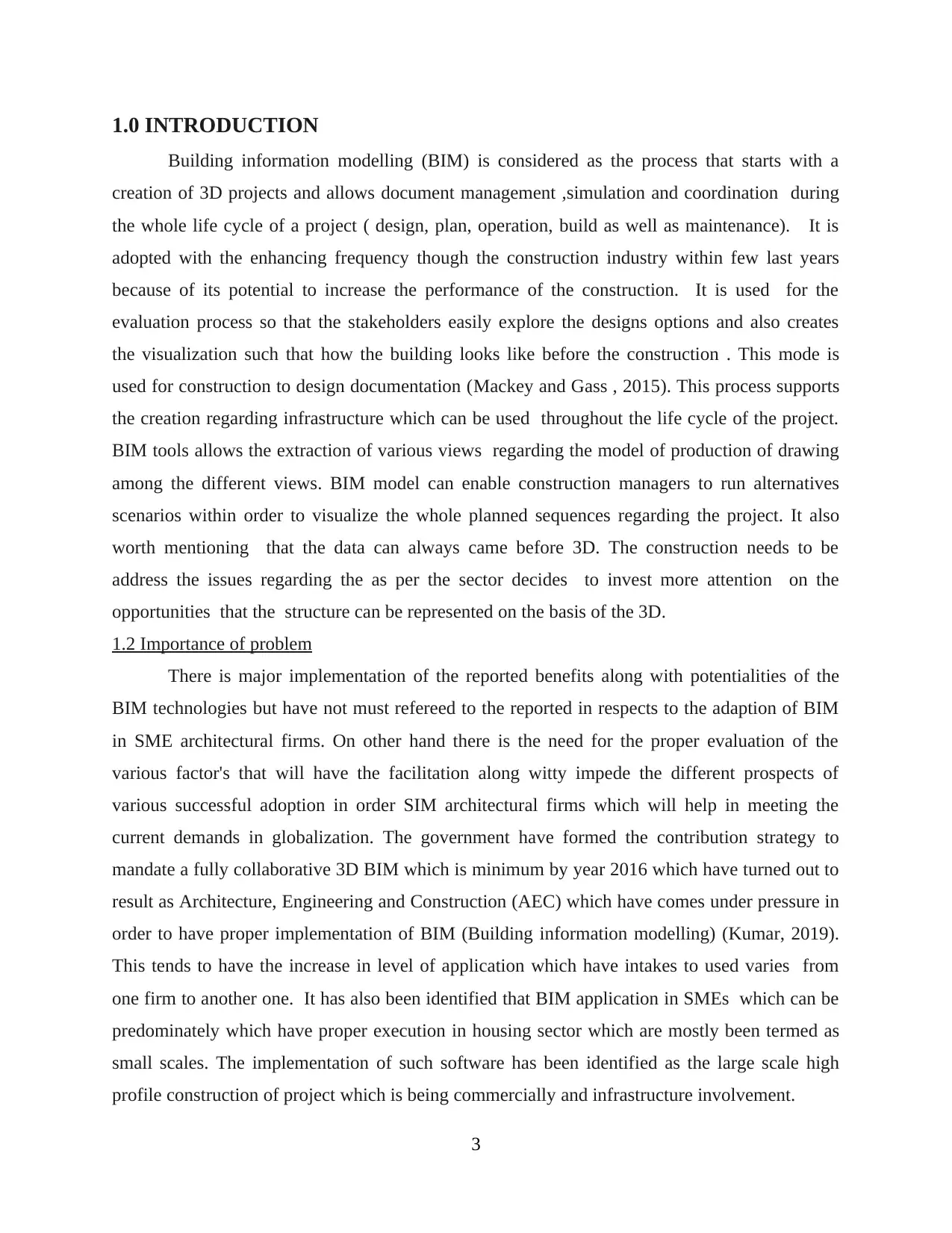
1.0 INTRODUCTION
Building information modelling (BIM) is considered as the process that starts with a
creation of 3D projects and allows document management ,simulation and coordination during
the whole life cycle of a project ( design, plan, operation, build as well as maintenance). It is
adopted with the enhancing frequency though the construction industry within few last years
because of its potential to increase the performance of the construction. It is used for the
evaluation process so that the stakeholders easily explore the designs options and also creates
the visualization such that how the building looks like before the construction . This mode is
used for construction to design documentation (Mackey and Gass , 2015). This process supports
the creation regarding infrastructure which can be used throughout the life cycle of the project.
BIM tools allows the extraction of various views regarding the model of production of drawing
among the different views. BIM model can enable construction managers to run alternatives
scenarios within order to visualize the whole planned sequences regarding the project. It also
worth mentioning that the data can always came before 3D. The construction needs to be
address the issues regarding the as per the sector decides to invest more attention on the
opportunities that the structure can be represented on the basis of the 3D.
1.2 Importance of problem
There is major implementation of the reported benefits along with potentialities of the
BIM technologies but have not must refereed to the reported in respects to the adaption of BIM
in SME architectural firms. On other hand there is the need for the proper evaluation of the
various factor's that will have the facilitation along witty impede the different prospects of
various successful adoption in order SIM architectural firms which will help in meeting the
current demands in globalization. The government have formed the contribution strategy to
mandate a fully collaborative 3D BIM which is minimum by year 2016 which have turned out to
result as Architecture, Engineering and Construction (AEC) which have comes under pressure in
order to have proper implementation of BIM (Building information modelling) (Kumar, 2019).
This tends to have the increase in level of application which have intakes to used varies from
one firm to another one. It has also been identified that BIM application in SMEs which can be
predominately which have proper execution in housing sector which are mostly been termed as
small scales. The implementation of such software has been identified as the large scale high
profile construction of project which is being commercially and infrastructure involvement.
3
Building information modelling (BIM) is considered as the process that starts with a
creation of 3D projects and allows document management ,simulation and coordination during
the whole life cycle of a project ( design, plan, operation, build as well as maintenance). It is
adopted with the enhancing frequency though the construction industry within few last years
because of its potential to increase the performance of the construction. It is used for the
evaluation process so that the stakeholders easily explore the designs options and also creates
the visualization such that how the building looks like before the construction . This mode is
used for construction to design documentation (Mackey and Gass , 2015). This process supports
the creation regarding infrastructure which can be used throughout the life cycle of the project.
BIM tools allows the extraction of various views regarding the model of production of drawing
among the different views. BIM model can enable construction managers to run alternatives
scenarios within order to visualize the whole planned sequences regarding the project. It also
worth mentioning that the data can always came before 3D. The construction needs to be
address the issues regarding the as per the sector decides to invest more attention on the
opportunities that the structure can be represented on the basis of the 3D.
1.2 Importance of problem
There is major implementation of the reported benefits along with potentialities of the
BIM technologies but have not must refereed to the reported in respects to the adaption of BIM
in SME architectural firms. On other hand there is the need for the proper evaluation of the
various factor's that will have the facilitation along witty impede the different prospects of
various successful adoption in order SIM architectural firms which will help in meeting the
current demands in globalization. The government have formed the contribution strategy to
mandate a fully collaborative 3D BIM which is minimum by year 2016 which have turned out to
result as Architecture, Engineering and Construction (AEC) which have comes under pressure in
order to have proper implementation of BIM (Building information modelling) (Kumar, 2019).
This tends to have the increase in level of application which have intakes to used varies from
one firm to another one. It has also been identified that BIM application in SMEs which can be
predominately which have proper execution in housing sector which are mostly been termed as
small scales. The implementation of such software has been identified as the large scale high
profile construction of project which is being commercially and infrastructure involvement.
3
⊘ This is a preview!⊘
Do you want full access?
Subscribe today to unlock all pages.

Trusted by 1+ million students worldwide
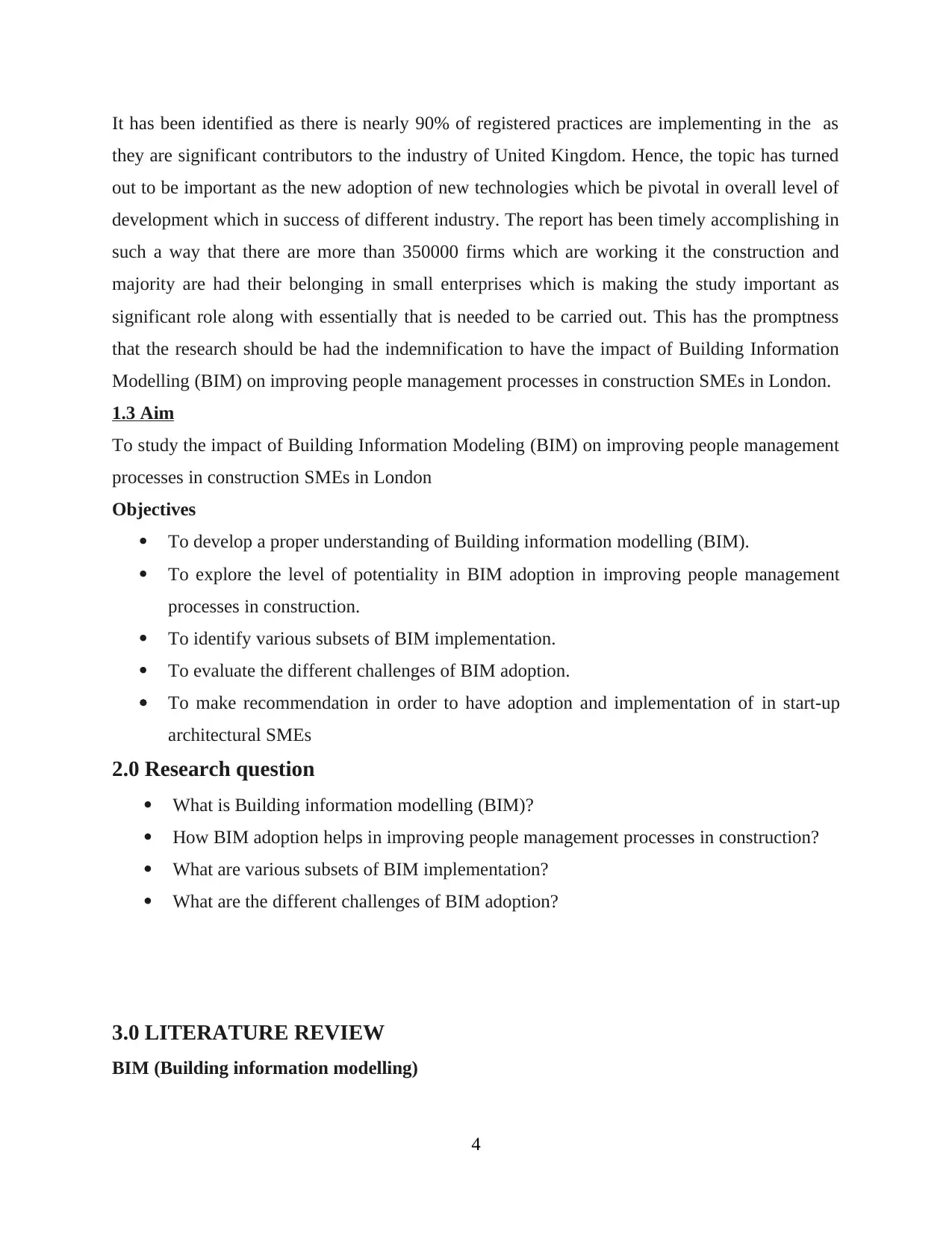
It has been identified as there is nearly 90% of registered practices are implementing in the as
they are significant contributors to the industry of United Kingdom. Hence, the topic has turned
out to be important as the new adoption of new technologies which be pivotal in overall level of
development which in success of different industry. The report has been timely accomplishing in
such a way that there are more than 350000 firms which are working it the construction and
majority are had their belonging in small enterprises which is making the study important as
significant role along with essentially that is needed to be carried out. This has the promptness
that the research should be had the indemnification to have the impact of Building Information
Modelling (BIM) on improving people management processes in construction SMEs in London.
1.3 Aim
To study the impact of Building Information Modeling (BIM) on improving people management
processes in construction SMEs in London
Objectives
To develop a proper understanding of Building information modelling (BIM).
To explore the level of potentiality in BIM adoption in improving people management
processes in construction.
To identify various subsets of BIM implementation.
To evaluate the different challenges of BIM adoption.
To make recommendation in order to have adoption and implementation of in start-up
architectural SMEs
2.0 Research question
What is Building information modelling (BIM)?
How BIM adoption helps in improving people management processes in construction?
What are various subsets of BIM implementation?
What are the different challenges of BIM adoption?
3.0 LITERATURE REVIEW
BIM (Building information modelling)
4
they are significant contributors to the industry of United Kingdom. Hence, the topic has turned
out to be important as the new adoption of new technologies which be pivotal in overall level of
development which in success of different industry. The report has been timely accomplishing in
such a way that there are more than 350000 firms which are working it the construction and
majority are had their belonging in small enterprises which is making the study important as
significant role along with essentially that is needed to be carried out. This has the promptness
that the research should be had the indemnification to have the impact of Building Information
Modelling (BIM) on improving people management processes in construction SMEs in London.
1.3 Aim
To study the impact of Building Information Modeling (BIM) on improving people management
processes in construction SMEs in London
Objectives
To develop a proper understanding of Building information modelling (BIM).
To explore the level of potentiality in BIM adoption in improving people management
processes in construction.
To identify various subsets of BIM implementation.
To evaluate the different challenges of BIM adoption.
To make recommendation in order to have adoption and implementation of in start-up
architectural SMEs
2.0 Research question
What is Building information modelling (BIM)?
How BIM adoption helps in improving people management processes in construction?
What are various subsets of BIM implementation?
What are the different challenges of BIM adoption?
3.0 LITERATURE REVIEW
BIM (Building information modelling)
4
Paraphrase This Document
Need a fresh take? Get an instant paraphrase of this document with our AI Paraphraser
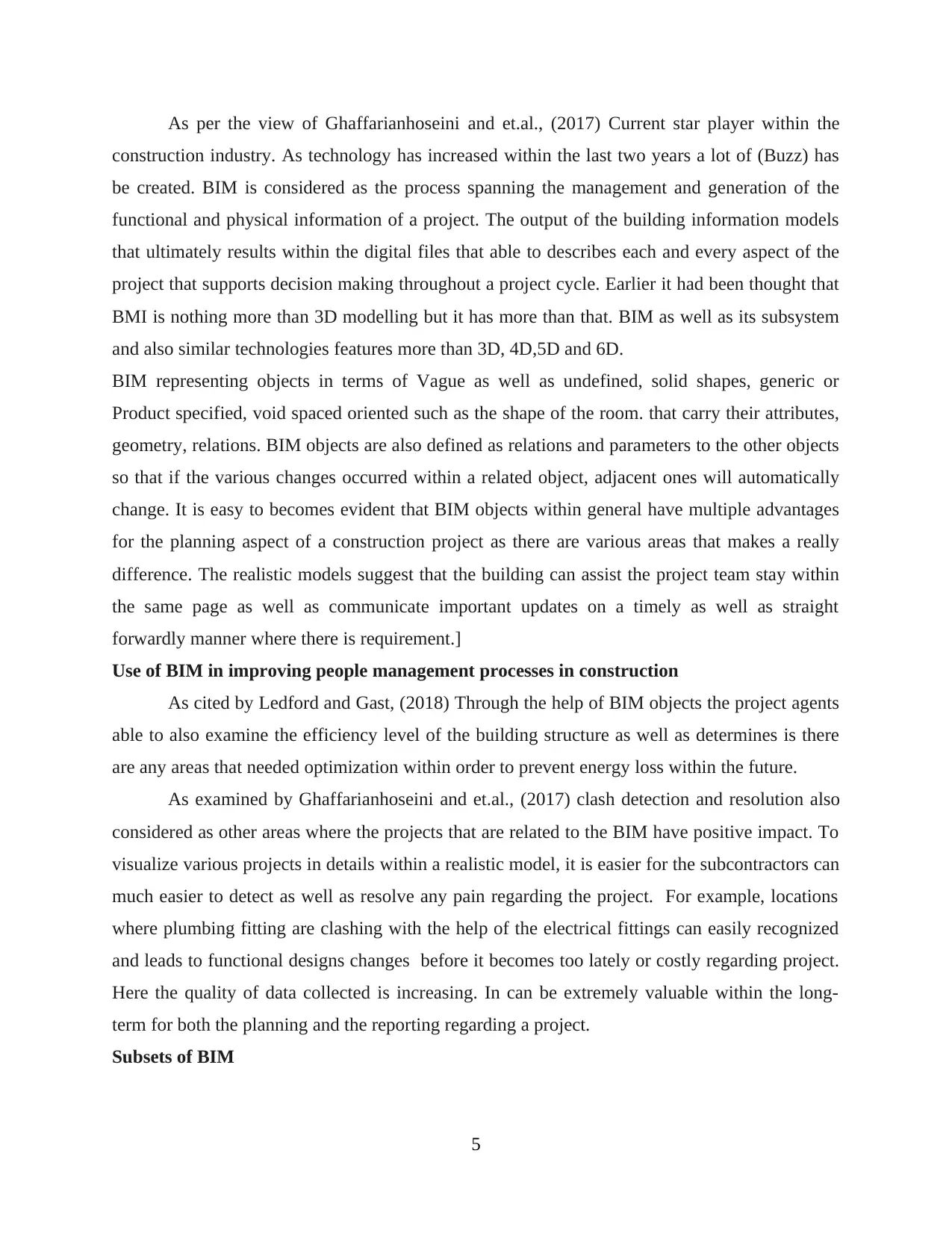
As per the view of Ghaffarianhoseini and et.al., (2017) Current star player within the
construction industry. As technology has increased within the last two years a lot of (Buzz) has
be created. BIM is considered as the process spanning the management and generation of the
functional and physical information of a project. The output of the building information models
that ultimately results within the digital files that able to describes each and every aspect of the
project that supports decision making throughout a project cycle. Earlier it had been thought that
BMI is nothing more than 3D modelling but it has more than that. BIM as well as its subsystem
and also similar technologies features more than 3D, 4D,5D and 6D.
BIM representing objects in terms of Vague as well as undefined, solid shapes, generic or
Product specified, void spaced oriented such as the shape of the room. that carry their attributes,
geometry, relations. BIM objects are also defined as relations and parameters to the other objects
so that if the various changes occurred within a related object, adjacent ones will automatically
change. It is easy to becomes evident that BIM objects within general have multiple advantages
for the planning aspect of a construction project as there are various areas that makes a really
difference. The realistic models suggest that the building can assist the project team stay within
the same page as well as communicate important updates on a timely as well as straight
forwardly manner where there is requirement.]
Use of BIM in improving people management processes in construction
As cited by Ledford and Gast, (2018) Through the help of BIM objects the project agents
able to also examine the efficiency level of the building structure as well as determines is there
are any areas that needed optimization within order to prevent energy loss within the future.
As examined by Ghaffarianhoseini and et.al., (2017) clash detection and resolution also
considered as other areas where the projects that are related to the BIM have positive impact. To
visualize various projects in details within a realistic model, it is easier for the subcontractors can
much easier to detect as well as resolve any pain regarding the project. For example, locations
where plumbing fitting are clashing with the help of the electrical fittings can easily recognized
and leads to functional designs changes before it becomes too lately or costly regarding project.
Here the quality of data collected is increasing. In can be extremely valuable within the long-
term for both the planning and the reporting regarding a project.
Subsets of BIM
5
construction industry. As technology has increased within the last two years a lot of (Buzz) has
be created. BIM is considered as the process spanning the management and generation of the
functional and physical information of a project. The output of the building information models
that ultimately results within the digital files that able to describes each and every aspect of the
project that supports decision making throughout a project cycle. Earlier it had been thought that
BMI is nothing more than 3D modelling but it has more than that. BIM as well as its subsystem
and also similar technologies features more than 3D, 4D,5D and 6D.
BIM representing objects in terms of Vague as well as undefined, solid shapes, generic or
Product specified, void spaced oriented such as the shape of the room. that carry their attributes,
geometry, relations. BIM objects are also defined as relations and parameters to the other objects
so that if the various changes occurred within a related object, adjacent ones will automatically
change. It is easy to becomes evident that BIM objects within general have multiple advantages
for the planning aspect of a construction project as there are various areas that makes a really
difference. The realistic models suggest that the building can assist the project team stay within
the same page as well as communicate important updates on a timely as well as straight
forwardly manner where there is requirement.]
Use of BIM in improving people management processes in construction
As cited by Ledford and Gast, (2018) Through the help of BIM objects the project agents
able to also examine the efficiency level of the building structure as well as determines is there
are any areas that needed optimization within order to prevent energy loss within the future.
As examined by Ghaffarianhoseini and et.al., (2017) clash detection and resolution also
considered as other areas where the projects that are related to the BIM have positive impact. To
visualize various projects in details within a realistic model, it is easier for the subcontractors can
much easier to detect as well as resolve any pain regarding the project. For example, locations
where plumbing fitting are clashing with the help of the electrical fittings can easily recognized
and leads to functional designs changes before it becomes too lately or costly regarding project.
Here the quality of data collected is increasing. In can be extremely valuable within the long-
term for both the planning and the reporting regarding a project.
Subsets of BIM
5
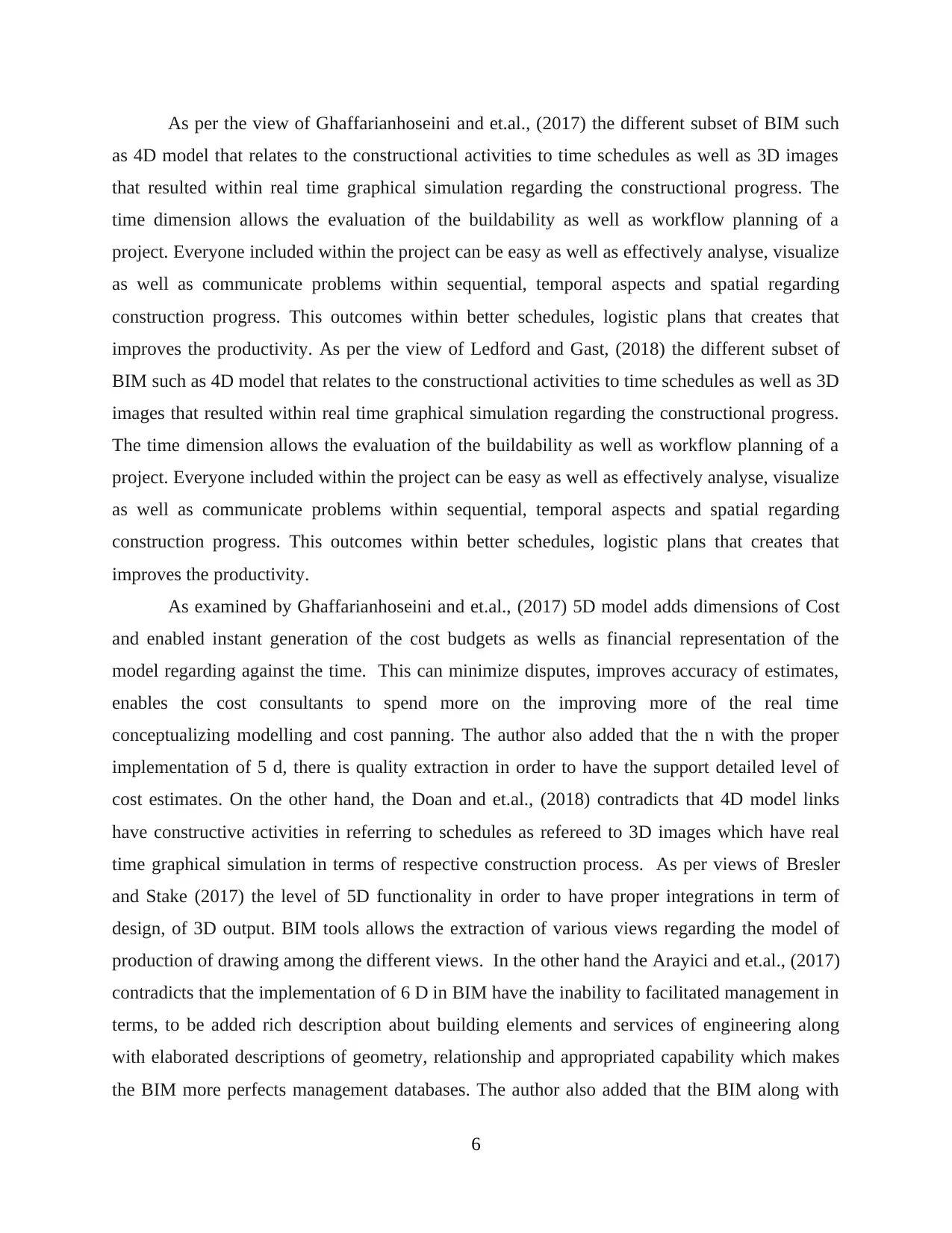
As per the view of Ghaffarianhoseini and et.al., (2017) the different subset of BIM such
as 4D model that relates to the constructional activities to time schedules as well as 3D images
that resulted within real time graphical simulation regarding the constructional progress. The
time dimension allows the evaluation of the buildability as well as workflow planning of a
project. Everyone included within the project can be easy as well as effectively analyse, visualize
as well as communicate problems within sequential, temporal aspects and spatial regarding
construction progress. This outcomes within better schedules, logistic plans that creates that
improves the productivity. As per the view of Ledford and Gast, (2018) the different subset of
BIM such as 4D model that relates to the constructional activities to time schedules as well as 3D
images that resulted within real time graphical simulation regarding the constructional progress.
The time dimension allows the evaluation of the buildability as well as workflow planning of a
project. Everyone included within the project can be easy as well as effectively analyse, visualize
as well as communicate problems within sequential, temporal aspects and spatial regarding
construction progress. This outcomes within better schedules, logistic plans that creates that
improves the productivity.
As examined by Ghaffarianhoseini and et.al., (2017) 5D model adds dimensions of Cost
and enabled instant generation of the cost budgets as wells as financial representation of the
model regarding against the time. This can minimize disputes, improves accuracy of estimates,
enables the cost consultants to spend more on the improving more of the real time
conceptualizing modelling and cost panning. The author also added that the n with the proper
implementation of 5 d, there is quality extraction in order to have the support detailed level of
cost estimates. On the other hand, the Doan and et.al., (2018) contradicts that 4D model links
have constructive activities in referring to schedules as refereed to 3D images which have real
time graphical simulation in terms of respective construction process. As per views of Bresler
and Stake (2017) the level of 5D functionality in order to have proper integrations in term of
design, of 3D output. BIM tools allows the extraction of various views regarding the model of
production of drawing among the different views. In the other hand the Arayici and et.al., (2017)
contradicts that the implementation of 6 D in BIM have the inability to facilitated management in
terms, to be added rich description about building elements and services of engineering along
with elaborated descriptions of geometry, relationship and appropriated capability which makes
the BIM more perfects management databases. The author also added that the BIM along with
6
as 4D model that relates to the constructional activities to time schedules as well as 3D images
that resulted within real time graphical simulation regarding the constructional progress. The
time dimension allows the evaluation of the buildability as well as workflow planning of a
project. Everyone included within the project can be easy as well as effectively analyse, visualize
as well as communicate problems within sequential, temporal aspects and spatial regarding
construction progress. This outcomes within better schedules, logistic plans that creates that
improves the productivity. As per the view of Ledford and Gast, (2018) the different subset of
BIM such as 4D model that relates to the constructional activities to time schedules as well as 3D
images that resulted within real time graphical simulation regarding the constructional progress.
The time dimension allows the evaluation of the buildability as well as workflow planning of a
project. Everyone included within the project can be easy as well as effectively analyse, visualize
as well as communicate problems within sequential, temporal aspects and spatial regarding
construction progress. This outcomes within better schedules, logistic plans that creates that
improves the productivity.
As examined by Ghaffarianhoseini and et.al., (2017) 5D model adds dimensions of Cost
and enabled instant generation of the cost budgets as wells as financial representation of the
model regarding against the time. This can minimize disputes, improves accuracy of estimates,
enables the cost consultants to spend more on the improving more of the real time
conceptualizing modelling and cost panning. The author also added that the n with the proper
implementation of 5 d, there is quality extraction in order to have the support detailed level of
cost estimates. On the other hand, the Doan and et.al., (2018) contradicts that 4D model links
have constructive activities in referring to schedules as refereed to 3D images which have real
time graphical simulation in terms of respective construction process. As per views of Bresler
and Stake (2017) the level of 5D functionality in order to have proper integrations in term of
design, of 3D output. BIM tools allows the extraction of various views regarding the model of
production of drawing among the different views. In the other hand the Arayici and et.al., (2017)
contradicts that the implementation of 6 D in BIM have the inability to facilitated management in
terms, to be added rich description about building elements and services of engineering along
with elaborated descriptions of geometry, relationship and appropriated capability which makes
the BIM more perfects management databases. The author also added that the BIM along with
6
⊘ This is a preview!⊘
Do you want full access?
Subscribe today to unlock all pages.

Trusted by 1+ million students worldwide
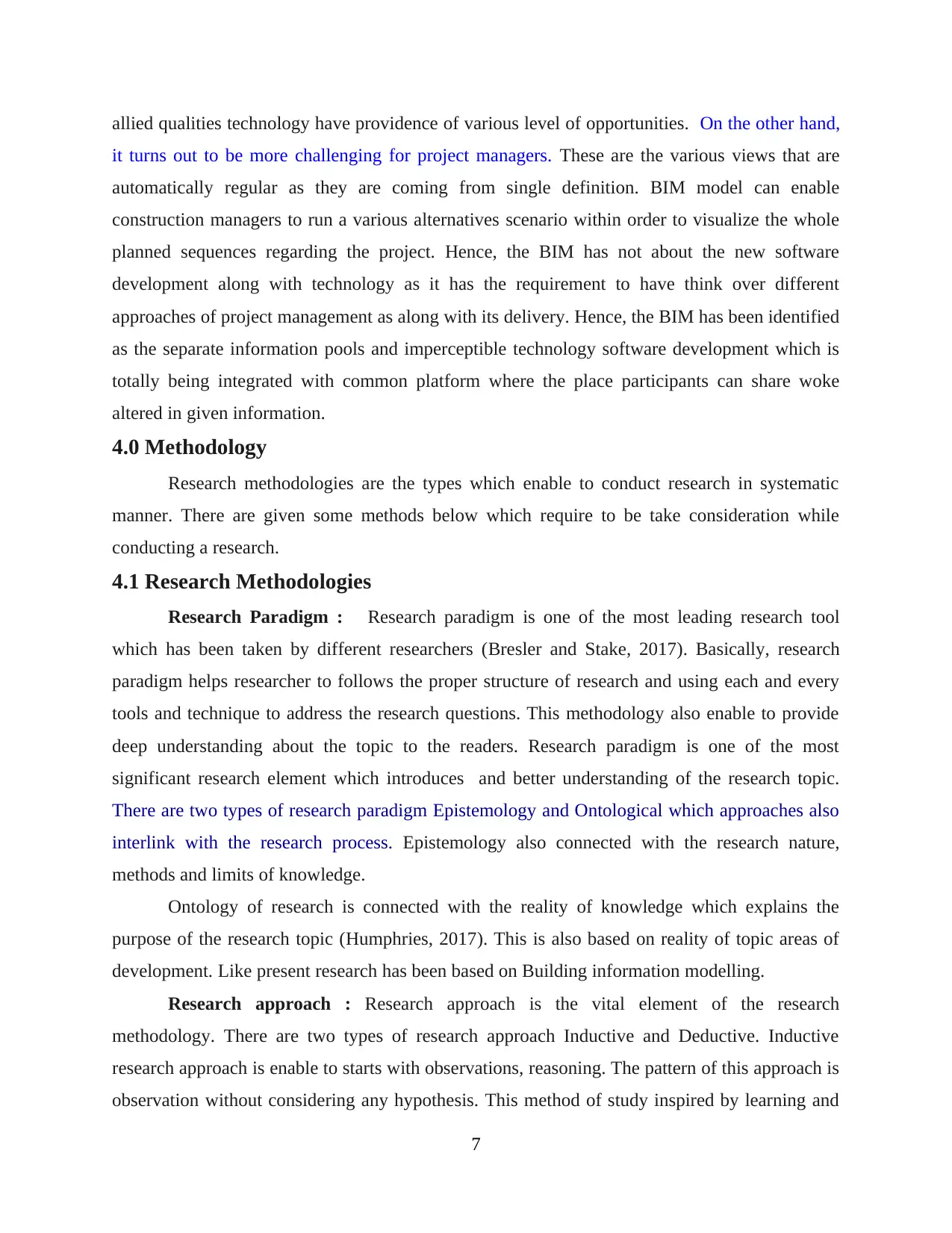
allied qualities technology have providence of various level of opportunities. On the other hand,
it turns out to be more challenging for project managers. These are the various views that are
automatically regular as they are coming from single definition. BIM model can enable
construction managers to run a various alternatives scenario within order to visualize the whole
planned sequences regarding the project. Hence, the BIM has not about the new software
development along with technology as it has the requirement to have think over different
approaches of project management as along with its delivery. Hence, the BIM has been identified
as the separate information pools and imperceptible technology software development which is
totally being integrated with common platform where the place participants can share woke
altered in given information.
4.0 Methodology
Research methodologies are the types which enable to conduct research in systematic
manner. There are given some methods below which require to be take consideration while
conducting a research.
4.1 Research Methodologies
Research Paradigm : Research paradigm is one of the most leading research tool
which has been taken by different researchers (Bresler and Stake, 2017). Basically, research
paradigm helps researcher to follows the proper structure of research and using each and every
tools and technique to address the research questions. This methodology also enable to provide
deep understanding about the topic to the readers. Research paradigm is one of the most
significant research element which introduces and better understanding of the research topic.
There are two types of research paradigm Epistemology and Ontological which approaches also
interlink with the research process. Epistemology also connected with the research nature,
methods and limits of knowledge.
Ontology of research is connected with the reality of knowledge which explains the
purpose of the research topic (Humphries, 2017). This is also based on reality of topic areas of
development. Like present research has been based on Building information modelling.
Research approach : Research approach is the vital element of the research
methodology. There are two types of research approach Inductive and Deductive. Inductive
research approach is enable to starts with observations, reasoning. The pattern of this approach is
observation without considering any hypothesis. This method of study inspired by learning and
7
it turns out to be more challenging for project managers. These are the various views that are
automatically regular as they are coming from single definition. BIM model can enable
construction managers to run a various alternatives scenario within order to visualize the whole
planned sequences regarding the project. Hence, the BIM has not about the new software
development along with technology as it has the requirement to have think over different
approaches of project management as along with its delivery. Hence, the BIM has been identified
as the separate information pools and imperceptible technology software development which is
totally being integrated with common platform where the place participants can share woke
altered in given information.
4.0 Methodology
Research methodologies are the types which enable to conduct research in systematic
manner. There are given some methods below which require to be take consideration while
conducting a research.
4.1 Research Methodologies
Research Paradigm : Research paradigm is one of the most leading research tool
which has been taken by different researchers (Bresler and Stake, 2017). Basically, research
paradigm helps researcher to follows the proper structure of research and using each and every
tools and technique to address the research questions. This methodology also enable to provide
deep understanding about the topic to the readers. Research paradigm is one of the most
significant research element which introduces and better understanding of the research topic.
There are two types of research paradigm Epistemology and Ontological which approaches also
interlink with the research process. Epistemology also connected with the research nature,
methods and limits of knowledge.
Ontology of research is connected with the reality of knowledge which explains the
purpose of the research topic (Humphries, 2017). This is also based on reality of topic areas of
development. Like present research has been based on Building information modelling.
Research approach : Research approach is the vital element of the research
methodology. There are two types of research approach Inductive and Deductive. Inductive
research approach is enable to starts with observations, reasoning. The pattern of this approach is
observation without considering any hypothesis. This method of study inspired by learning and
7
Paraphrase This Document
Need a fresh take? Get an instant paraphrase of this document with our AI Paraphraser
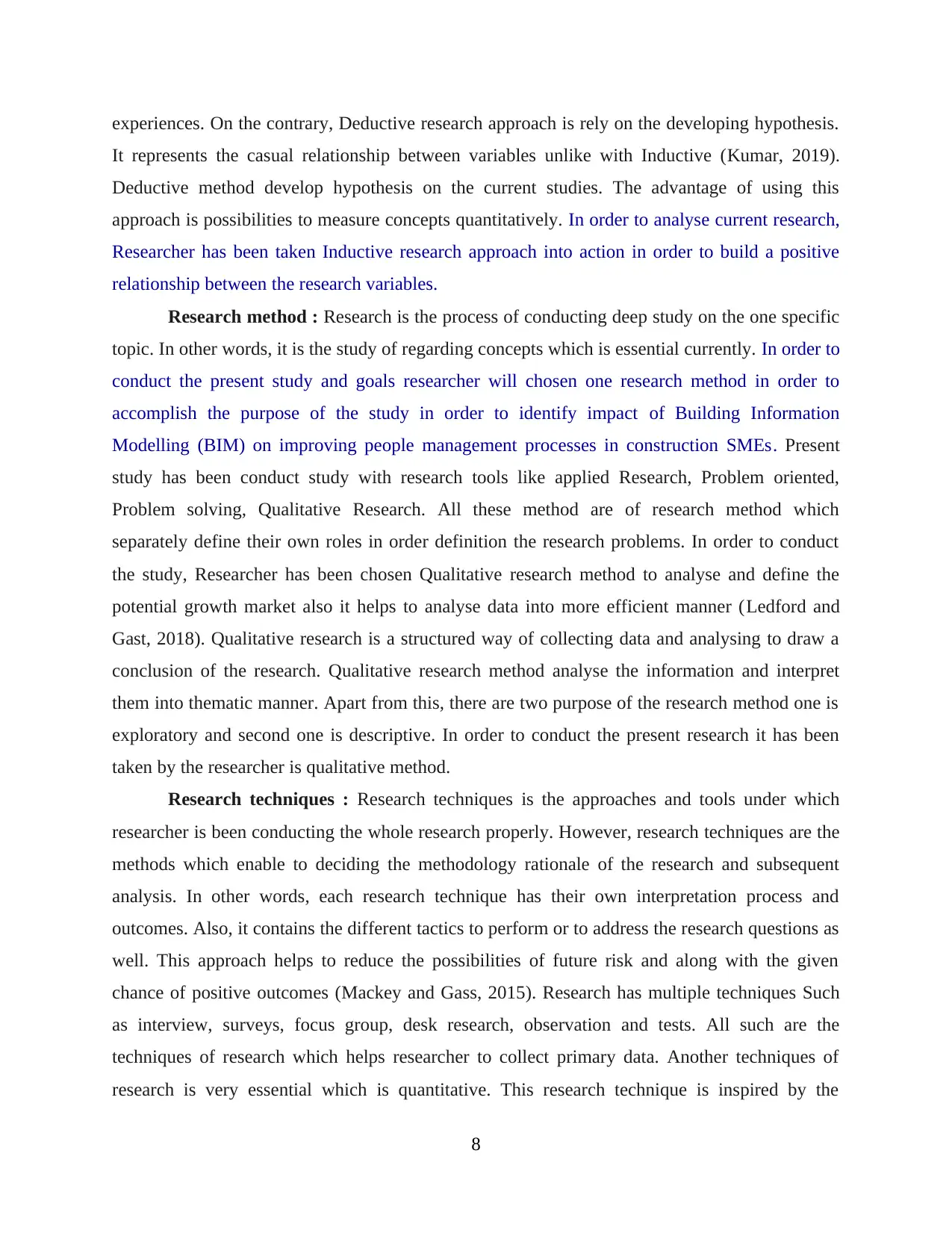
experiences. On the contrary, Deductive research approach is rely on the developing hypothesis.
It represents the casual relationship between variables unlike with Inductive (Kumar, 2019).
Deductive method develop hypothesis on the current studies. The advantage of using this
approach is possibilities to measure concepts quantitatively. In order to analyse current research,
Researcher has been taken Inductive research approach into action in order to build a positive
relationship between the research variables.
Research method : Research is the process of conducting deep study on the one specific
topic. In other words, it is the study of regarding concepts which is essential currently. In order to
conduct the present study and goals researcher will chosen one research method in order to
accomplish the purpose of the study in order to identify impact of Building Information
Modelling (BIM) on improving people management processes in construction SMEs. Present
study has been conduct study with research tools like applied Research, Problem oriented,
Problem solving, Qualitative Research. All these method are of research method which
separately define their own roles in order definition the research problems. In order to conduct
the study, Researcher has been chosen Qualitative research method to analyse and define the
potential growth market also it helps to analyse data into more efficient manner (Ledford and
Gast, 2018). Qualitative research is a structured way of collecting data and analysing to draw a
conclusion of the research. Qualitative research method analyse the information and interpret
them into thematic manner. Apart from this, there are two purpose of the research method one is
exploratory and second one is descriptive. In order to conduct the present research it has been
taken by the researcher is qualitative method.
Research techniques : Research techniques is the approaches and tools under which
researcher is been conducting the whole research properly. However, research techniques are the
methods which enable to deciding the methodology rationale of the research and subsequent
analysis. In other words, each research technique has their own interpretation process and
outcomes. Also, it contains the different tactics to perform or to address the research questions as
well. This approach helps to reduce the possibilities of future risk and along with the given
chance of positive outcomes (Mackey and Gass, 2015). Research has multiple techniques Such
as interview, surveys, focus group, desk research, observation and tests. All such are the
techniques of research which helps researcher to collect primary data. Another techniques of
research is very essential which is quantitative. This research technique is inspired by the
8
It represents the casual relationship between variables unlike with Inductive (Kumar, 2019).
Deductive method develop hypothesis on the current studies. The advantage of using this
approach is possibilities to measure concepts quantitatively. In order to analyse current research,
Researcher has been taken Inductive research approach into action in order to build a positive
relationship between the research variables.
Research method : Research is the process of conducting deep study on the one specific
topic. In other words, it is the study of regarding concepts which is essential currently. In order to
conduct the present study and goals researcher will chosen one research method in order to
accomplish the purpose of the study in order to identify impact of Building Information
Modelling (BIM) on improving people management processes in construction SMEs. Present
study has been conduct study with research tools like applied Research, Problem oriented,
Problem solving, Qualitative Research. All these method are of research method which
separately define their own roles in order definition the research problems. In order to conduct
the study, Researcher has been chosen Qualitative research method to analyse and define the
potential growth market also it helps to analyse data into more efficient manner (Ledford and
Gast, 2018). Qualitative research is a structured way of collecting data and analysing to draw a
conclusion of the research. Qualitative research method analyse the information and interpret
them into thematic manner. Apart from this, there are two purpose of the research method one is
exploratory and second one is descriptive. In order to conduct the present research it has been
taken by the researcher is qualitative method.
Research techniques : Research techniques is the approaches and tools under which
researcher is been conducting the whole research properly. However, research techniques are the
methods which enable to deciding the methodology rationale of the research and subsequent
analysis. In other words, each research technique has their own interpretation process and
outcomes. Also, it contains the different tactics to perform or to address the research questions as
well. This approach helps to reduce the possibilities of future risk and along with the given
chance of positive outcomes (Mackey and Gass, 2015). Research has multiple techniques Such
as interview, surveys, focus group, desk research, observation and tests. All such are the
techniques of research which helps researcher to collect primary data. Another techniques of
research is very essential which is quantitative. This research technique is inspired by the
8
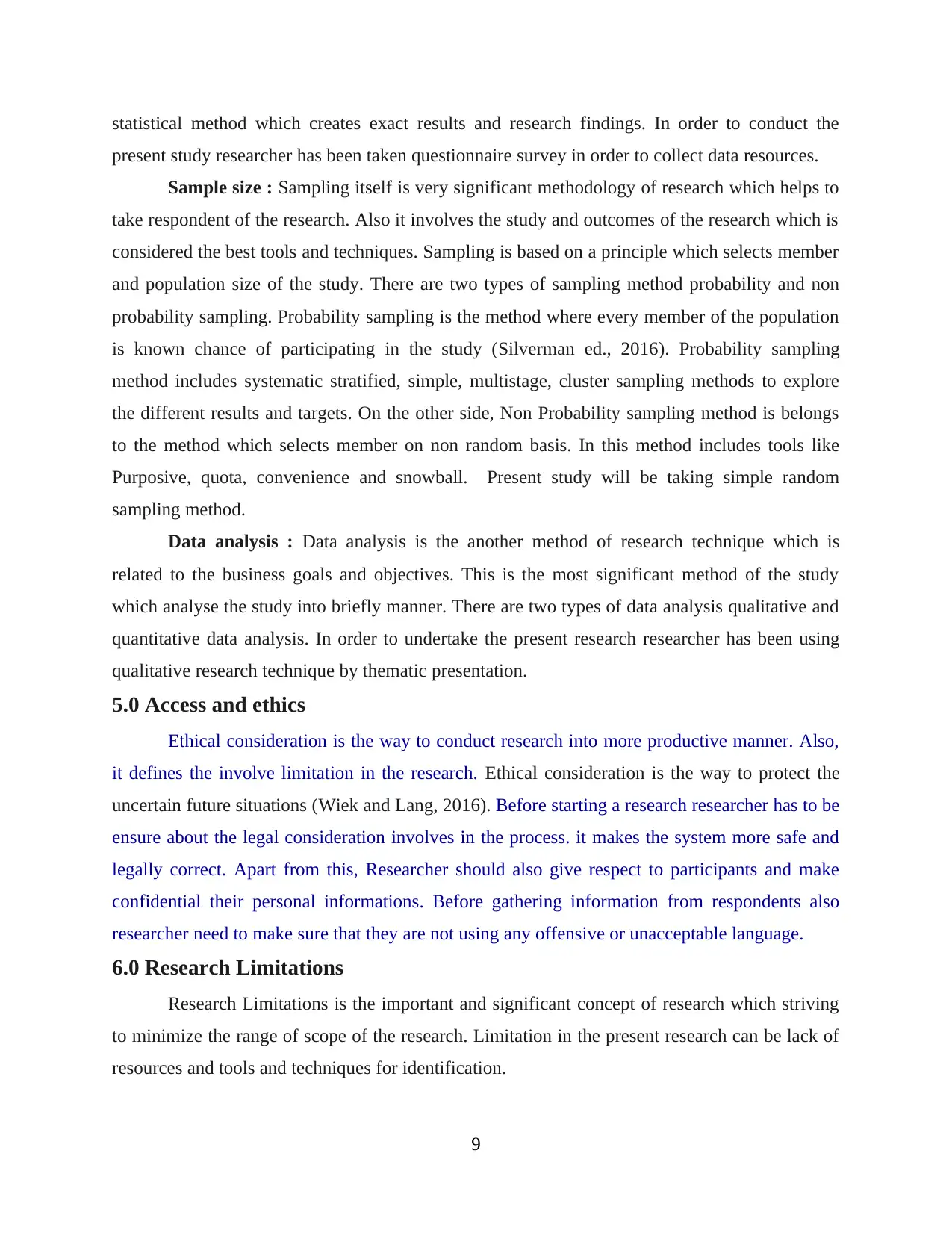
statistical method which creates exact results and research findings. In order to conduct the
present study researcher has been taken questionnaire survey in order to collect data resources.
Sample size : Sampling itself is very significant methodology of research which helps to
take respondent of the research. Also it involves the study and outcomes of the research which is
considered the best tools and techniques. Sampling is based on a principle which selects member
and population size of the study. There are two types of sampling method probability and non
probability sampling. Probability sampling is the method where every member of the population
is known chance of participating in the study (Silverman ed., 2016). Probability sampling
method includes systematic stratified, simple, multistage, cluster sampling methods to explore
the different results and targets. On the other side, Non Probability sampling method is belongs
to the method which selects member on non random basis. In this method includes tools like
Purposive, quota, convenience and snowball. Present study will be taking simple random
sampling method.
Data analysis : Data analysis is the another method of research technique which is
related to the business goals and objectives. This is the most significant method of the study
which analyse the study into briefly manner. There are two types of data analysis qualitative and
quantitative data analysis. In order to undertake the present research researcher has been using
qualitative research technique by thematic presentation.
5.0 Access and ethics
Ethical consideration is the way to conduct research into more productive manner. Also,
it defines the involve limitation in the research. Ethical consideration is the way to protect the
uncertain future situations (Wiek and Lang, 2016). Before starting a research researcher has to be
ensure about the legal consideration involves in the process. it makes the system more safe and
legally correct. Apart from this, Researcher should also give respect to participants and make
confidential their personal informations. Before gathering information from respondents also
researcher need to make sure that they are not using any offensive or unacceptable language.
6.0 Research Limitations
Research Limitations is the important and significant concept of research which striving
to minimize the range of scope of the research. Limitation in the present research can be lack of
resources and tools and techniques for identification.
9
present study researcher has been taken questionnaire survey in order to collect data resources.
Sample size : Sampling itself is very significant methodology of research which helps to
take respondent of the research. Also it involves the study and outcomes of the research which is
considered the best tools and techniques. Sampling is based on a principle which selects member
and population size of the study. There are two types of sampling method probability and non
probability sampling. Probability sampling is the method where every member of the population
is known chance of participating in the study (Silverman ed., 2016). Probability sampling
method includes systematic stratified, simple, multistage, cluster sampling methods to explore
the different results and targets. On the other side, Non Probability sampling method is belongs
to the method which selects member on non random basis. In this method includes tools like
Purposive, quota, convenience and snowball. Present study will be taking simple random
sampling method.
Data analysis : Data analysis is the another method of research technique which is
related to the business goals and objectives. This is the most significant method of the study
which analyse the study into briefly manner. There are two types of data analysis qualitative and
quantitative data analysis. In order to undertake the present research researcher has been using
qualitative research technique by thematic presentation.
5.0 Access and ethics
Ethical consideration is the way to conduct research into more productive manner. Also,
it defines the involve limitation in the research. Ethical consideration is the way to protect the
uncertain future situations (Wiek and Lang, 2016). Before starting a research researcher has to be
ensure about the legal consideration involves in the process. it makes the system more safe and
legally correct. Apart from this, Researcher should also give respect to participants and make
confidential their personal informations. Before gathering information from respondents also
researcher need to make sure that they are not using any offensive or unacceptable language.
6.0 Research Limitations
Research Limitations is the important and significant concept of research which striving
to minimize the range of scope of the research. Limitation in the present research can be lack of
resources and tools and techniques for identification.
9
⊘ This is a preview!⊘
Do you want full access?
Subscribe today to unlock all pages.

Trusted by 1+ million students worldwide
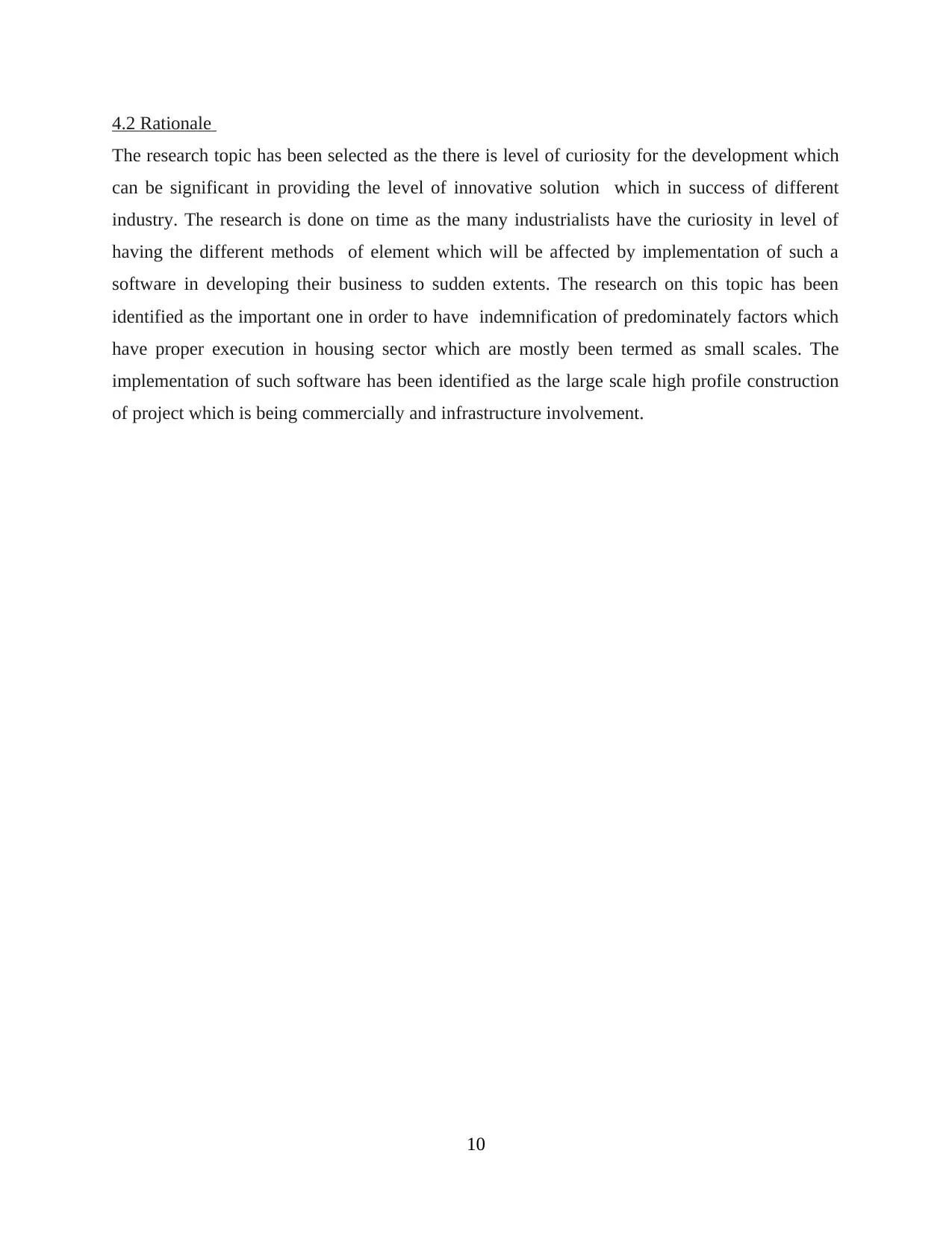
4.2 Rationale
The research topic has been selected as the there is level of curiosity for the development which
can be significant in providing the level of innovative solution which in success of different
industry. The research is done on time as the many industrialists have the curiosity in level of
having the different methods of element which will be affected by implementation of such a
software in developing their business to sudden extents. The research on this topic has been
identified as the important one in order to have indemnification of predominately factors which
have proper execution in housing sector which are mostly been termed as small scales. The
implementation of such software has been identified as the large scale high profile construction
of project which is being commercially and infrastructure involvement.
10
The research topic has been selected as the there is level of curiosity for the development which
can be significant in providing the level of innovative solution which in success of different
industry. The research is done on time as the many industrialists have the curiosity in level of
having the different methods of element which will be affected by implementation of such a
software in developing their business to sudden extents. The research on this topic has been
identified as the important one in order to have indemnification of predominately factors which
have proper execution in housing sector which are mostly been termed as small scales. The
implementation of such software has been identified as the large scale high profile construction
of project which is being commercially and infrastructure involvement.
10
Paraphrase This Document
Need a fresh take? Get an instant paraphrase of this document with our AI Paraphraser
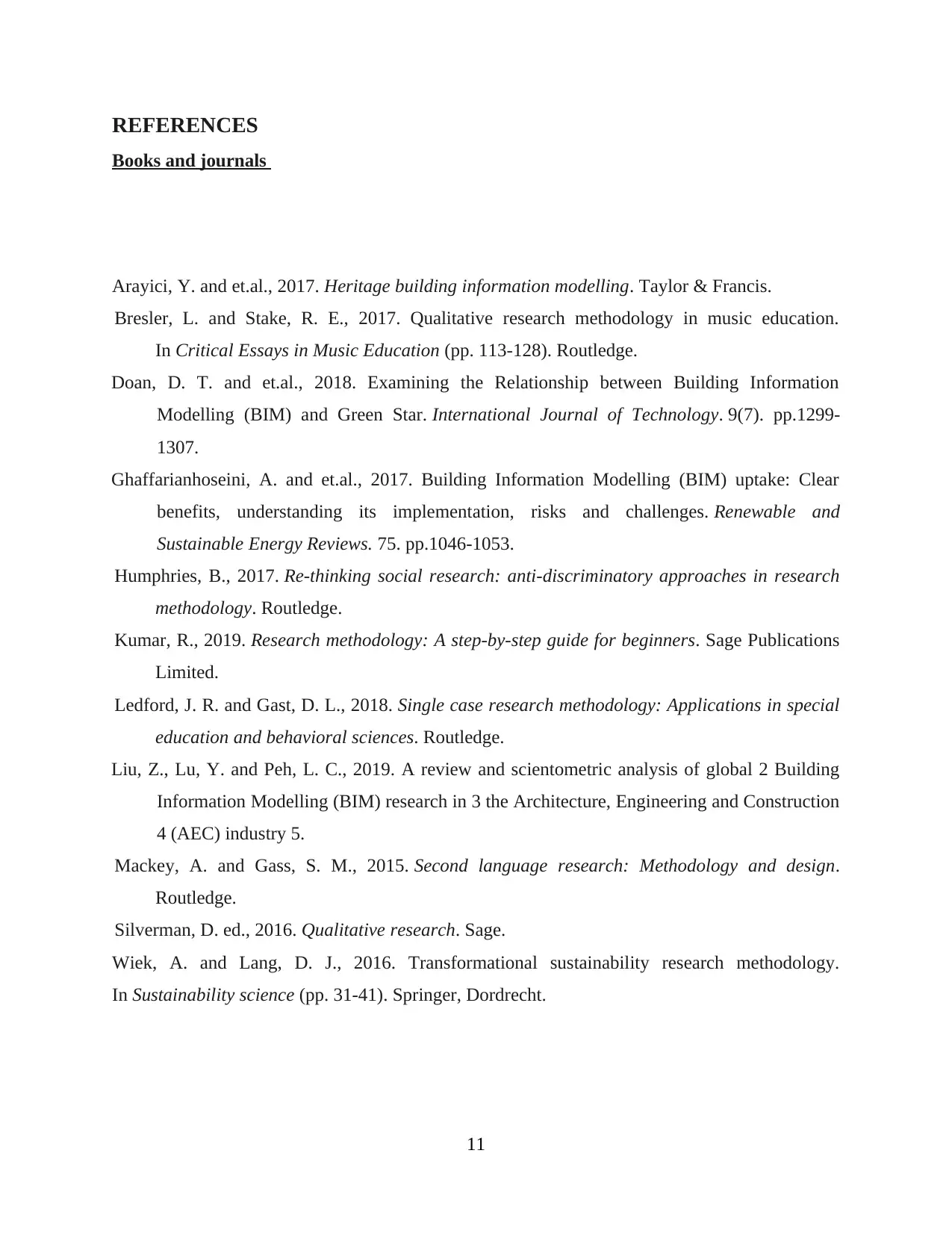
REFERENCES
Books and journals
Arayici, Y. and et.al., 2017. Heritage building information modelling. Taylor & Francis.
Bresler, L. and Stake, R. E., 2017. Qualitative research methodology in music education.
In Critical Essays in Music Education (pp. 113-128). Routledge.
Doan, D. T. and et.al., 2018. Examining the Relationship between Building Information
Modelling (BIM) and Green Star. International Journal of Technology. 9(7). pp.1299-
1307.
Ghaffarianhoseini, A. and et.al., 2017. Building Information Modelling (BIM) uptake: Clear
benefits, understanding its implementation, risks and challenges. Renewable and
Sustainable Energy Reviews. 75. pp.1046-1053.
Humphries, B., 2017. Re-thinking social research: anti-discriminatory approaches in research
methodology. Routledge.
Kumar, R., 2019. Research methodology: A step-by-step guide for beginners. Sage Publications
Limited.
Ledford, J. R. and Gast, D. L., 2018. Single case research methodology: Applications in special
education and behavioral sciences. Routledge.
Liu, Z., Lu, Y. and Peh, L. C., 2019. A review and scientometric analysis of global 2 Building
Information Modelling (BIM) research in 3 the Architecture, Engineering and Construction
4 (AEC) industry 5.
Mackey, A. and Gass, S. M., 2015. Second language research: Methodology and design.
Routledge.
Silverman, D. ed., 2016. Qualitative research. Sage.
Wiek, A. and Lang, D. J., 2016. Transformational sustainability research methodology.
In Sustainability science (pp. 31-41). Springer, Dordrecht.
11
Books and journals
Arayici, Y. and et.al., 2017. Heritage building information modelling. Taylor & Francis.
Bresler, L. and Stake, R. E., 2017. Qualitative research methodology in music education.
In Critical Essays in Music Education (pp. 113-128). Routledge.
Doan, D. T. and et.al., 2018. Examining the Relationship between Building Information
Modelling (BIM) and Green Star. International Journal of Technology. 9(7). pp.1299-
1307.
Ghaffarianhoseini, A. and et.al., 2017. Building Information Modelling (BIM) uptake: Clear
benefits, understanding its implementation, risks and challenges. Renewable and
Sustainable Energy Reviews. 75. pp.1046-1053.
Humphries, B., 2017. Re-thinking social research: anti-discriminatory approaches in research
methodology. Routledge.
Kumar, R., 2019. Research methodology: A step-by-step guide for beginners. Sage Publications
Limited.
Ledford, J. R. and Gast, D. L., 2018. Single case research methodology: Applications in special
education and behavioral sciences. Routledge.
Liu, Z., Lu, Y. and Peh, L. C., 2019. A review and scientometric analysis of global 2 Building
Information Modelling (BIM) research in 3 the Architecture, Engineering and Construction
4 (AEC) industry 5.
Mackey, A. and Gass, S. M., 2015. Second language research: Methodology and design.
Routledge.
Silverman, D. ed., 2016. Qualitative research. Sage.
Wiek, A. and Lang, D. J., 2016. Transformational sustainability research methodology.
In Sustainability science (pp. 31-41). Springer, Dordrecht.
11
1 out of 11
Related Documents
Your All-in-One AI-Powered Toolkit for Academic Success.
+13062052269
info@desklib.com
Available 24*7 on WhatsApp / Email
![[object Object]](/_next/static/media/star-bottom.7253800d.svg)
Unlock your academic potential
Copyright © 2020–2025 A2Z Services. All Rights Reserved. Developed and managed by ZUCOL.




